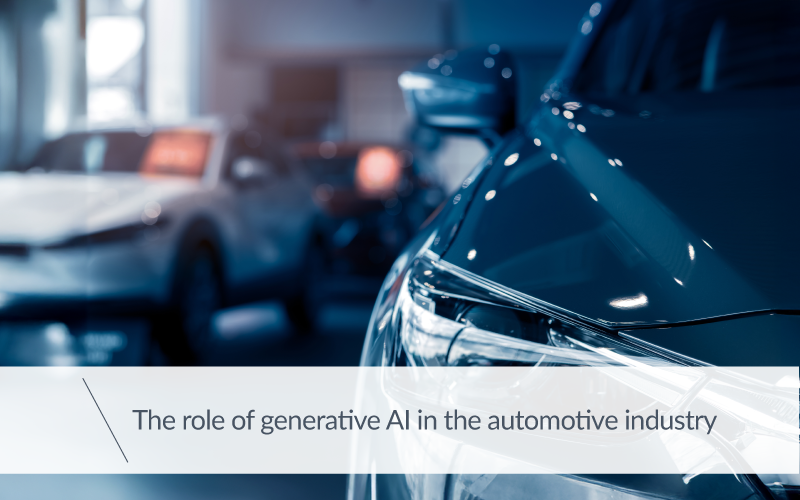
The automotive industry is undergoing an unprecedented phase of transformation - a genuine revolution driven by technological advancements. Digital innovations, particularly artificial intelligence (AI), machine learning (ML), and, more recently, generative AI, are radically changing every phase of a vehicle's life cycle.
From the design and production processes to supply chain management and the in-vehicle experience, AI is no longer a marginal support but a strategic pillar.
This evolution is not simply limited to the incremental improvement of existing technologies. Instead, it is redefining business models, production logic, and even the role of the car in society, transforming it from a simple means of transport into a component of an intelligent, connected, and personalised ecosystem.
In this scenario, generative AI stands out for its unique ability to combine computational creativity and engineering optimisation. This is not simply about accelerating processes; it's about unlocking new design and functional possibilities, offering solutions that were previously unthinkable.
To fully understand its impact, we need to analyse the context of this transformation and observe how the applications of generative AI are influencing the sector's main areas, including design and production, vehicle connectivity and new forms of human-machine interaction.
A sector in deep evolution: from traditional industry to intelligent mobility
The automotive sector, historically based on established processes and standardised production lines, is now facing challenges that demand a radical rethink.
The growing demand for sustainability, the push towards electrification, the spread of autonomous and connected vehicles, and the need to reduce development times and costs are just some of the forces driving companies towards more flexible, digitalised, and responsive production models.
In this context, AI and ML have become essential tools for ensuring competitiveness: they improve operational efficiency, support quality control, and enable predictive maintenance strategies that minimise machine downtime.
However, the real paradigm shift comes with generative AI. This technology is not limited to processing data or predicting behaviour; it can create, simulate, and optimise innovative design solutions, going way beyond the boundaries of traditional engineering.
It is this creative capacity, combined with computational precision, that makes generative AI a key element in tackling the complexities of new mobility.
Design and development: computational creativity for innovation
One of the areas most revolutionised by generative AI is undoubtedly vehicle design. Traditional methods, based on sequential iterations and physical prototypes, are giving way to a computational approach that allows thousands of design variants to be explored simultaneously.
Generative algorithms can evaluate structural parameters, functional constraints, and sustainability goals, generating solutions that optimise weight, strength, and aerodynamics. This means lighter, higher-performance components that improve not only energy efficiency but also vehicle safety and durability.
Digital simulations are another crucial aspect of this transformation. Thanks to advanced models, it is possible to virtually test dynamic performance, crash test scenarios, behaviour on different road surfaces, and consumption, drastically reducing the need to build physical prototypes.
This virtual-first approach accelerates development times, reduces costs, and contributes to a more sustainable design by limiting material waste. It's not just about efficiency; generative AI enables a more creative and daring design, offering solutions that even the most experienced engineer could not have possibly conceived without the additional aid of these technologies.
Smart production: automation, quality, and resilience
The digital transformation of the automotive sector is not just about the design phase. Production is also undergoing a profound evolution, with AI and Machine Learning forming the backbone of the Industry 4.0 paradigm.
Advanced robotics, IoT sensors, and cloud computing platforms are now integrated into production lines, enabling constant performance monitoring and real-time quality control. In this scenario, generative AI plays a strategic role by providing predictive models that can anticipate anomalies, optimize production flows, and improve manufacturing precision.
Quality control becomes more sophisticated: machine vision systems, supported by ML, detect defects imperceptible to the human eye, while predictive models reduce the risk of sudden failures thanks to proactive maintenance. The integration of these tools not only reduces operational costs but also increases the resilience of the entire production system, making it capable of adapting quickly to changes in demand and potential supply chain disruptions.
Intelligent supply chain and predictive logistics
The complexity of the automotive supply chain now requires advanced tools to face the challenges of an increasingly uncertain global market. Generative AI, together with other advanced analysis technologies, allows for proactive and dynamic management of the supply chain.
Sophisticated algorithms allow companies to predict demand fluctuations with great precision, optimize inventory levels, and plan procurement more efficiently. This translates into reduced storage costs, greater production continuity, and a better ability to respond to market needs.
Integration with IoT sensors and real-time tracking platforms increases transparency and visibility throughout the entire supply chain, improving system resilience and reducing risks related to interruptions or delays.
In a context where operational continuity is a decisive competitive factor, these capabilities represent a strategic advantage for vehicle manufacturers.
From a car as a product to a car as an intelligent ecosystem
While innovations in design and production form the basis of this transformation, the most consumer-perceivable applications of generative AI are found inside the vehicle.
Cars are no longer simple means of transport but intelligent platforms capable of offering personalised experiences and multimodal interactions. Generative AI allows for the creation of dynamic graphic interfaces, virtual assistants that can dialogue naturally, and adaptive services based on user behaviour. This means, for example, personalised in-car sounds, virtual avatars that interact with the driver, and infotainment systems that can generate content in real-time.
These features don't just improve comfort; they also impact safety. Integration with driver-assistance systems and sensors makes it possible to analyse the surrounding environment in real-time, anticipate risk situations, and support the driver with predictive warnings.
In autonomous vehicles, these capabilities become essential for ensuring timely and reliable decisions in complex scenarios, confirming the role of generative AI as a central element in the mobility of the future.
Vehicle communication and semantic networks
Vehicle connectivity is another area where generative AI is opening up new frontiers. Vehicle-to-Vehicle (V2V) and Vehicle-to-Infrastructure (V2I) communication networks aim to reduce accidents and congestion through the continuous exchange of information. However, transmitting high-resolution images and data in real-time poses challenges related to bandwidth and latency.
To overcome them, approaches based on semantic communication are being developed, where only essential information is sent and images are reconstructed on the receiving vehicle using generative models.
This technique drastically reduces the volume of data transmitted while also protecting privacy by filtering sensitive elements such as faces and license plates. Furthermore, reinforcement learning algorithms, such as Double Deep Q-Networks (DDQN), optimize the management of network resources, ensuring the stability and quality of the communication experience.
These developments forecast a future where collaboration between vehicles will become a pillar of road safety and traffic flow efficiency.
The future of automotive in the era of generative AI
The massive adoption of generative AI marks a paradigm shift for the automotive industry. It is not a simple technological enhancement but a profound transformation that redefines the very concept of the automobile, shifting it towards a model of intelligent, safe, and personalised mobility.
However, this revolution brings with it crucial challenges, from the protection of privacy to the management of algorithmic bias and the need for training policies to mitigate the impact on human labour.
The potential of generative AI is immense: cars capable of learning, communicating, and interacting naturally; vehicle networks capable of preventing accidents; and factories that self-optimise in real-time.
Achieving this future will require a balance between innovation, ethics, and governance, but the signs are clear: generative AI could be the driving force behind the mobility of tomorrow, transforming the driving experience into a safer, more efficient, and deeply connected form of transport.



